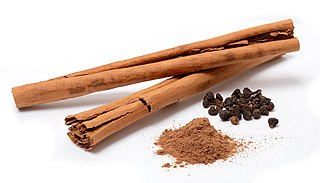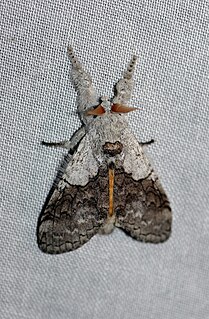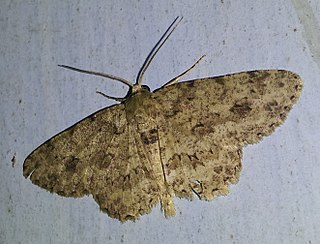Related Research Articles

Cinnamon is a spice obtained from the inner bark of several tree species from the genus Cinnamomum. Cinnamon is used mainly as an aromatic condiment and flavouring additive in a wide variety of cuisines, sweet and savoury dishes, breakfast cereals, snackfoods, tea and traditional foods. The aroma and flavour of cinnamon derive from its essential oil and principal component, cinnamaldehyde, as well as numerous other constituents including eugenol.

Cassia fistula, commonly known as golden shower, purging cassia, Indian laburnum, or pudding-pipe tree, is a flowering plant in the subfamily, Caesalpinioideae of the legume family, Fabaceae. The species is native to the Indian subcontinent and adjacent regions of Southeast Asia. It ranges from eastward throughout India to Myanmar and Thailand and south to Sri Lanka and southern Pakistan. It is a popular ornamental plant and is also used in herbal medicine. It is both the national tree and national flower of Thailand. It is the state flower of Kerala in India.

Syzygium cumini, commonly known as Malabar plum, Java plum, black plum, jamun or jambolan, is an evergreen tropical tree in the flowering plant family Myrtaceae, and favored for its fruit, timber, and ornamental value. It is native to the Indian Subcontinent, adjoining regions of Southeast Asia, including Myanmar, Sri Lanka, and the Andaman Islands. It can reach heights of up to 30 metres (98 ft) and can live more than 100 years. A rapidly growing plant, it is considered an invasive species in many world regions.

The Sri Lanka dry-zone dry evergreen forests are a tropical dry broadleaf forest ecoregion of the island of Sri Lanka.

The primary form of agriculture in Sri Lanka is rice production. Rice is cultivated during Maha and Yala seasons. Tea is cultivated in the central highlands and is a major source of foreign exchange. Vegetables, fruits and oilseed crops are also cultivated in the country. There are two Agriculture Parks abbreviated as A.Parks established by the Department of Agriculture. Out of the total population in Sri Lanka, 31.8% engages in agricultural activities. Agriculture and allied sectors like forestry and fisheries accounted for 18% of the GDP in 2014, about 26.4% of the workforce or employment.

Kumana National Park in Sri Lanka is renowned for its avifauna, particularly its large flocks of migratory waterfowl and wading birds. The park is 391 kilometres (243 mi) southeast of Colombo on Sri Lanka's southeastern coast. Kumana is contiguous with Yala National Park. Kumana was formerly known as Yala East National Park, but changed to its present name on 5 September 2006.
Cryptophlebia ombrodelta, the litchi fruit moth or macadamia nut borer, is a moth of the family Tortricidae. The species was first described by Oswald Bertram Lower in 1898. It is native to India, Sri Lanka, Nepal, Indonesia, China, Taiwan, Vietnam, Thailand, western Malaysia, New Guinea, the Philippines, Japan, Guam, the Caroline Islands, Australia and has been introduced to Hawaii.
Archips micaceana is a moth of the family Tortricidae. It is found in China, Hong Kong, southern Vietnam, Burma, and northern Thailand. It is a minor pest of many agricultural crops.

Striglina scitaria, the daincha leaf webber, is a species of moth of the family Thyrididae described by Francis Walker in 1862. It is found in Taiwan, Japan, India, Sri Lanka, Maldives, Myanmar, the Andamans, Borneo, New Guinea, Fiji and Australia. It is a major pest which mainly attacks legume crops.
Indarbela quadrinotata, the bark-eating caterpillar, is a moth in the family Cossidae. It is found in India and Sri Lanka. It was described by Francis Walker in 1856.
Strepsicrates rhothia is a species of moth of the family Tortricidae first described by Edward Meyrick in 1910. It is found in Taiwan, Sri Lanka, India, the Democratic Republic of the Congo, Ghana, Madagascar, Mauritius and South Africa.

Kunugia latipennis, the pine lappet moth, is a moth of the family Lasiocampidae. The species was first described by Francis Walker in 1855.
Suana concolor is a moth of the family Lasiocampidae first described by Francis Walker in 1855. It is found in India and Sri Lanka, to South China, Java, Borneo and the Philippines.
Fodina stola is a moth of the family Noctuidae first described by Achille Guenée in 1852. It is found in India and Sri Lanka. Caterpillars are known to feed on Anogeissus latifolia, Cassia fistula, Holarrhena antidysenterica, Holarrhena pubescens and Tabernaemontana heyneana.

Calliteara horsfieldii, or Horsfield's tussock moth, is a moth of the family Erebidae. The species was first described by Saunders in 1851.

Lymantria ampla is a moth of the family Erebidae first described by Francis Walker in 1855. It is found in India and Sri Lanka.
Chrysocraspeda olearia is a moth of the family Geometridae first described by Achille Guenée in 1857. It is found in oriental regions such as India, Sri Lanka, and some Far-East Asian countries.

Ectropis bhurmitra, the tea twig caterpillar, is a moth of the family Geometridae. The species was first described by Francis Walker in 1860. A widespread Asian species, it is found around Indo-Australian tropics from India, Sri Lanka and Hong Kong, Taiwan, Thailand, New Guinea to Australian Queensland and the Solomon Islands.
Zamarada baliata is a moth of the family Geometridae first described by Felder in 1874. It is found in Sundaland and most likely in India and Sri Lanka.
Trachylepidia fructicassiella is a moth of the family Pyralidae first described by Émile Louis Ragonot in 1887. It is found in India, Pakistan and Sri Lanka.
References
- ↑ "Species Details: Cusiala raptaria Walker, 1860". Catalogue of Life. Retrieved 7 March 2018.
- ↑ Koçak, Ahmet Ömer; Kemal, Muhabbet (20 February 2012). "Preliminary list of the Lepidoptera of Sri Lanka". Cesa News. Centre for Entomological Studies Ankara (79): 1–57 – via Academia.
- ↑ "Cassia fistula L." NewCROP. Purdue University. 3 July 1996. Retrieved 7 March 2018.
- ↑ "HOSTS - a Database of the World's Lepidopteran Hostplants". The Natural History Museum. Retrieved 7 March 2018.
| This Boarmiini-related article is a stub. You can help Wikipedia by expanding it. |